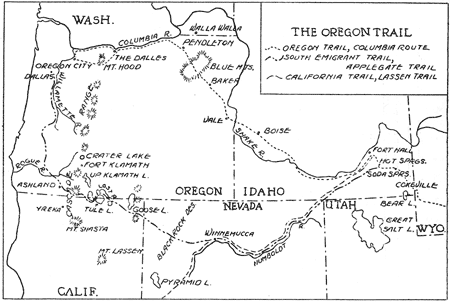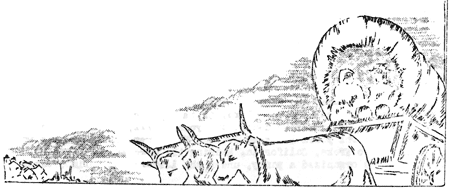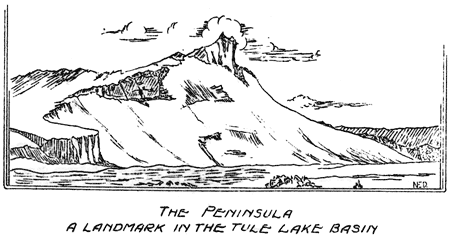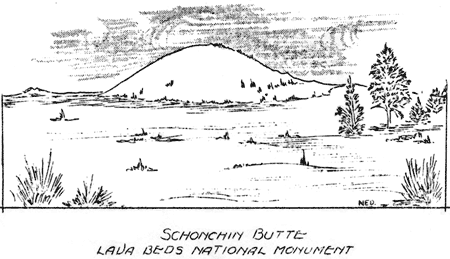|
Volume X No. 1 - June, 1937
Outline Of Events In The History Of The Modoc War
By Don C. Fisher, Assistant Chief Ranger and
John E. Doerr, Jr., Park Naturalist

Introduction
Beginning with this number of Nature Notes from Crater Lake
National Park, and continuing through Volume X which will be issued
during the summer months of 1937, Nature Notes will present an
Outline of the Events in the History of the Modoc War. In preparing
this outline the authors have described briefly the important events in
the development of south central Oregon and northeastern California
during the period 1846-1873. That period was one of constant struggle
between the white settlers and the Modoc Indians. There were acts of
treachery, murders, massacres and numerous councils, culminating in the
Modoc War of 1872 - 1873. The most important battles of the war took
place in the area of what is now the Lava Beds National Monument in
northeastern California. The places where important events of the war
took place are among the most interesting features of the Monument. -
Editor

(click on image for an enlargement in a new window)
Part I
1846 - 1870
| 1846 |
South Emigrant Trail (Applegate Trail) established. |
|
Lindsay Applegate, accompanied by fourteen other settlers in the
Willamette and Rogue valleys in western Oregon, established the South
Emigrant Trail between a point on the Oregon Trail near Fort Hall, Idaho
and the Willamette Valley. The purpose of this new route, shown on the
map on the opposite page, were to encourage settlers to western Oregon,
to eliminate the hazards encountered on the Columbia Route, to provide
an alternate route in the event of trouble with England, Hudson's Bay
Company controlled the Columbia Route, and to provide a route which
would be open except for a short winter season each year.
From what is now Dalles, Oregon, the Applegate party went south up
the Willamette Valley, through the Umpqua and Rogue River valleys to a
point near what is now Ashland, Oregon. From there the party proceeded
eastward, crossing the Cascade Range near Green Springs Mountain, to
Spencer Creek near the present town of Keno, Oregon. From there a route
was selected around the south end of Lower Klamath Lake, then northward
along the high ground between Lower Klamath Lake and Tule Lake to a ford
on Lost River ("Stone Bridge"). Passing north of Tule Lake and Clear
Lake the party continued eastward to Goose Lake, then southeast across
the Black Rock Desert to what is now Winnemucca on the Humboldt River in
Nevada. Following up river about 200 miles, then continuing northeast,
the party reached Hot Springs Valley on the Oregon Trail, about 50 miles
southeast of Fort Hall, Idaho.
The first emigrants to reach western Oregon by way of the South
Emigrant Trail arrived in the fall of 1846, having been conducted west
by the Applegate party on their return from Hot Springs Valley.
Lindsay Applegate and his party were the first white men to enter
what is now the Lava Beds National Monument. On their exploring trip
eastward they attempted to pass around the south end of Tule Lake but
the rough lava along the shore forced them to seek a route around the
north end of the lake. Visitors going to the Lava Beds National
Monument by way of the road south of Merrill, Oregon, cross Lost River
at the "Stone Bridge" over which hundreds of emigrants passed on their
way to western Oregon. A monument near the bridge records the names of
the men in the Applegate party.
Many of the events of the Modoc War took place along the South
Emigrant Trail.

|
| 1847-51 |
Modoc Indians molested emigrants on the South Emigrant Trail. |
|
The Modoc Indians, numbering about 600 warriors under the leadership
of Old Chief Schonchin, inhabited the region around Lower Klamath Lake,
Tule Lake, and Lost River in northern California and southern Oregon.
The Modoc Indians were part of the Klamath tribe, a division of the
tribe having taken place many years before the first white men came into
the region.
|
|
California became a state in 1850. |
| 1852 |
First massacre of emigrants by Modoc Indians at Bloody Point. |
|
In September the Modocs destroyed an emigrant train at Bloody Point
on the east shore of Tule Lake. Of the 65 persons in the train only
three escaped immediate death; two young girls, taken prisoners and
killed several years later by jealous Modoc women, and one man who made
his way to Yreka, California. Hearing the news of the massacre, Yreka
settlers organized a party, under the leadership of Jim Crosby, to go to
the scene of the massacre to bury the dead and avenge their death.
Crosby's party had one skirmish with a band of Modocs.
|
| 1853-55 |
Modoc Indians continued to harass and massacre emigrants on the
South Emigrant Trail. |
| 1856 |
Ben Wright Massacre. |
|
The depredations and massacres of emigrants by the Modoc Indians
aroused settlers at Yreka, California to send out a party under Ben
Wright's leadership. Accounts differ as to what actually took place
when Wright's party finally met the Indians on Lost River. Both the
white men and the Indians anticipated treachery. Each group planned to
exterminate the other. To prevent the gathering of the entire tribe
which would result in his party being greatly outnumbered, Wright
attacked, killing approximately 80 Indians. This loss broke the power
of the tribe but kindled the Modoc hatred for the white people, a hatred
which flamed up many times in the years following.

|
| 1857-62 |
Modoc Indians continued to harass and massacre emigrants on the
South Emigrant Trail. |
|
History does not record the actual number of emigrants killed nor
the number of wagon trains destroyed. It has been estimated that at
least 300 emigrants and settlers were killed by the Modoc Indians during
the years 1846 to 1873.
|
|
Oregon became a state in 1859. |
| 1863 |
Fort Klamath established. |
|
This fort was built by Captain William Kelly, Co. "C" 1st Oregon
Cavalry. It was built on the trail between the Upper Klamath Valley and
Jacksonville, Oregon. Fort Klamath remained an army post until 1889 at
which time it was abandoned. The paved highway between the present town
of Fort Klamath and Annie Spring, in Crater Lake National Park, and west
to Medford follows closely the route of the old military road built
across the Cascade Range by soldiers stationed at Forth Klamath. Some
of the early events in the history of Crater Lake occurred in connection
with the building of the military road.
|
| 1864 |
Treaty between the United States and the Klamath, Modoc, and Snake
(Yahooskin band) Indians.
The Klamath Reservation established. |
|
Under the terms of this treaty the Modoc Indians, with old Chief
Schonchin as their leader, gave up their lands in the Lost River, Tule
Lake and Lower Klamath Lake regions, and moved to the reservation in the
Upper Klamath Valley. Approximately 160 Modoc Indians under the
leadership of Keintpoos (Captain Jack), refused to move to the
reservation even though they had agreed to do so in signing the treaty.
It was Captain Jack's band of Modocs that caused the trouble which
precipitated the Modoc War. The majority of the Modoc tribe under Old
Chief Schonchin remained on the reservation, taking no part in the Modoc
War.
|
| 1865 |
Captain McGregor, Commanding Officer at Fort Klamath, made and
unsuccessful attempt to get Captain Jack and his band to the
reservation. |
| 1866 |
Lindsay Applegate, Agent on the reservation, failed in an attempt to
get Captain Jack's band to the reservation. |
| 1867 |
Captain Jack's band of Modocs continue to harass settlers in the
Lost River Valley.
J. W. Perit Huntington, Superintendent of Indian
Affairs for Oregon, made an unsuccessful attempt to get Jack's band to
the reservation.
First building erected on the site of Linkville
(Klamath Falls, Oregon) by George Nurse and Edgar Overton. |
| 1869 |
Captain Jack and his band of Modocs moved to the
reservation. |
|
This move was accomplished following a council between Captain Jack;
A. B. Meacham, Superintendent of Indian Affairs for Oregon; O. C. Knapp,
Agent on the reservation; Ivan D. Applegate, Sub Agent at Yainax; and W.
C. McKay. Talk at the council accomplished nothing. When troops
suddenly appeared at the meeting place the Indian warriors fled, leaving
their women and children behind. Meacham put the women and children in
wagons and started for the reservation. "Queen" Mary, Captain Jack's
sister, was permitted to go to Captain Jack to persuade him to move to
the reservation. Her efforts were successful. Arriving on the
reservation, Jack and his band prepared to make permanent homes at Modoc
Point.
|
| 1870 |
Captain Jack and his band left the reservation and returned to their
former homes on Lost River. |
|
Shortly after Captain Jack and his band started building permanent
homes at Modoc Point, the Klamath Indians began to molest them, making
it necessary for the band to move to another part of the reservation.
Several attempts were made to find a location. The Klamaths continued
to harass the band until finally Captain Jack and his followers left the
reservation and returned to Lost River. During the summer months that
Captain Jack had been on the reservation a number of settlers had taken
up land in the Lost River region.
(To be continued)
|

|

